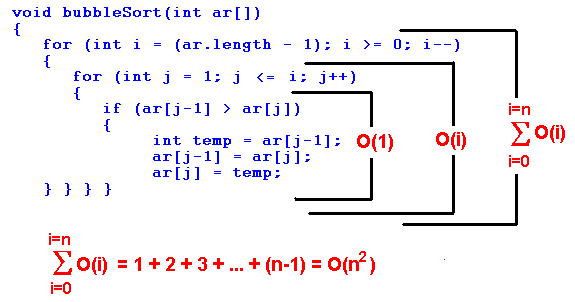
Sorting is ordering a list of objects. We can distinguish two types of sorting. If the number of objects is small enough to fits into the main memory, sorting is called internal sorting. If the number of objects is so large that some of them reside on external storage during the sort, it is called external sorting. In this chapter we consider the following internal sorting algorithms
Suppose we need to sort an array of positive integers {3,11,2,9,1,5}. A bucket sort works as follows: create an array of size 11. Then, go through the input array and place integer 3 into a second array at index 3, integer 11 at index 11 and so on. We will end up with a sorted list in the second array.
Suppose we are sorting a large number of local phone numbers, for example, all residential phone numbers in the 412 area code region (about 1 million) We sort the numbers without use of comparisons in the following way. Create an a bit array of size 107. It takes about 1Mb. Set all bits to 0. For each phone number turn-on the bit indexed by that phone number. Finally, walk through the array and for each bit 1 record its index, which is a phone number.
We immediately see two drawbacks to this sorting algorithm. Firstly, we must know how to handle duplicates. Secondly, we must know the maximum value in the unsorted array.. Thirdly, we must have enough memory - it may be impossible to declare an array large enough on some systems.
The first problem is solved by using linked lists, attached to each array index. All duplicates for that bucket will be stored in the list. Another possible solution is to have a counter. As an example let us sort 3, 2, 4, 2, 3, 5. We start with an array of 5 counters set to zero.
| 0 | 1 | 2 | 3 | 4 | 5 |
| 0 | 0 | 0 | 0 | 0 | 0 |
| 0 | 1 | 2 | 3 | 4 | 5 |
| 0 | 0 | 2 | 2 | 1 | 1 |
2 2 3 3 4 5.
void bubbleSort(int ar[])
{
for (int i = (ar.length - 1); i >= 0; i--)
{
for (int j = 1; j ≤ i; j++)
{
if (ar[j-1] > ar[j])
{
int temp = ar[j-1];
ar[j-1] = ar[j];
ar[j] = temp;
} } } }
7, 5, 2, 4, 3, 9The worst-case runtime complexity is O(n2). See explanation below
5, 7, 2, 4, 3, 9
5, 2, 7, 4, 3, 9
5, 2, 4, 7, 3, 9
5, 2, 4, 3, 7, 9
5, 2, 4, 3, 7, 9

The selection sort works as follows: you look through the entire array for the smallest element, once you find it you swap it (the smallest element) with the first element of the array. Then you look for the smallest element in the remaining array (an array without the first element) and swap it with the second element. Then you look for the smallest element in the remaining array (an array without first and second elements) and swap it with the third element, and so on. Here is an example,
void selectionSort(int[] ar){
for (int i = 0; i ‹ ar.length-1; i++)
{
int min = i;
for (int j = i+1; j ‹ ar.length; j++)
if (ar[j] ‹ ar[min]) min = j;
int temp = ar[i];
ar[i] = ar[min];
ar[min] = temp;
} }
29, 64, 73, 34, 20,The worst-case runtime complexity is O(n2).
20, 64, 73, 34, 29,
20, 29, 73, 34, 64
20, 29, 34, 73, 64
20, 29, 34, 64, 73
void insertionSort(int[] ar)
{
for (int i=1; i ‹ ar.length; i++)
{
int index = ar[i]; int j = i;
while (j > 0 && ar[j-1] > index)
{
ar[j] = ar[j-1];
j--;
}
ar[j] = index;
} }
29, 20, 73, 34, 64Let us compute the worst-time complexity of the insertion sort. In sorting the most expensive part is a comparison of two elements. Surely that is a dominant factor in the running time. We will calculate the number of comparisons of an array of N elements:
29, 20, 73, 34, 64
20, 29, 73, 34, 64
20, 29, 73, 34, 64
20, 29, 34, 73, 64
20, 29, 34, 64, 73
we need 0 comparisons to insert the first elementTotally,
we need 1 comparison to insert the second element
we need 2 comparisons to insert the third element
...
we need (N-1) comparisons (at most) to insert the last element
1 + 2 + 3 + ... + (N-1) = O(n2)The worst-case runtimecomplexity is O(n2).What is the best-case runtime complexity? O(n). The advantage of insertion sort comparing it to the previous two sorting algorithm is that insertion sort runs in linear time on nearly sorted data.
27 10 12 25 34 16 15 31
27 10 12 25 34 16 15 31
27 10 12 25 34 16 15 31
27 10 12 25 34 16 15 31
merge (cleverly-!) parts
10 27 12 25 16 34 15 31
10 12 25 27 15 16 31 34
10 12 15 16 25 27 31 34
How do we merge two sorted subarrays? We define three references at the front of each array.
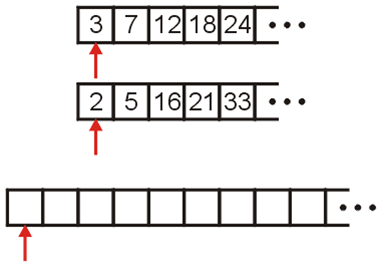
We keep picking the smallest element and move it to a temporary array, incrementing the corresponding indices.
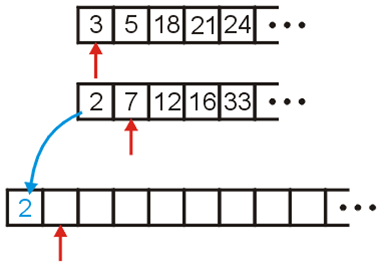
See implementation details in in MergeSort.java.
T(n) = 2*T(n/2) + n - 1
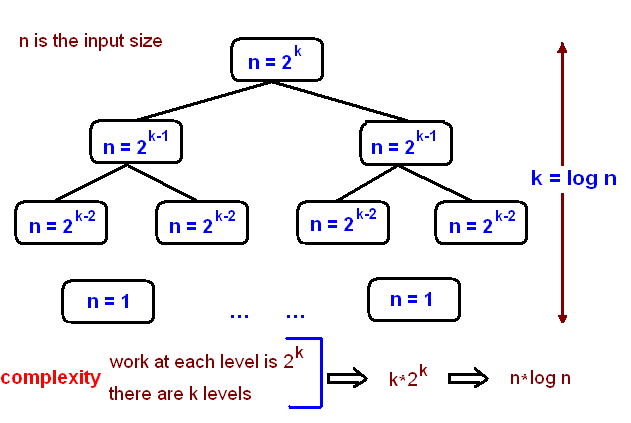
What is the lower bound (the least running time in the worst-case) for all sorting comparison algorithms? A lower bound is a mathematical argument saying you can't hope to go faster than a certain amount. The preceding section presented O(n log n) mergesort, but is this the best we can do? In this section we show that any sorting algorithm that sorts using comparisons must make O(n log n) such comparisons.
Suppose we have N elements. How many different arrangements can you make? There are N possible choices for the first element, (N-1) possible choices for the second element, .. and so on. Multiplying them, we get N! (N factorial.)
Next, we observe that each comparison cut down the number of all possible comparisons by a factor 2. Any comparison sorting algorithm can always be put in the form of a decision tree. And conversely, a tree like this can be used as a sorting algorithm. This figure illustrates sorting a list of {a1, a2, a3} in the form of a dedcision tree:
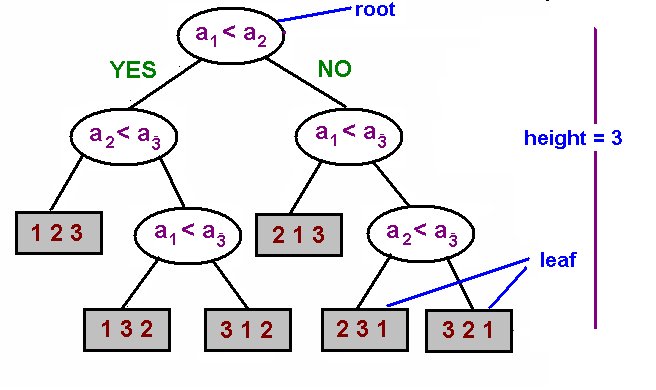
Arrays.sort method
int[] a1 = {3,4,1,5,2,6};
Arrays.sort(a1);
Comparable interface. This interface contains only one method with the following signature:
public int compareTo(Object obj);
The returned value is negative, zero or positive depending on whether this object is less, equals or greater than parameter object. Note a difference between the equals() and compareTo() methods. In the following code example we design a class of playing cards that can be compared based on their values:
class Card implements Comparable<Card>
{
private String suit;
private int value;
public Card(String suit, int value)
{
this.suit = suit;
this.value = value;
}
public int getValue()
{
return value;
}
public String getSuit()
{
return suit;
}
public int compareTo(Card x)
{
return getValue() - x.getValue();
}
}
Suppose that the Card class implements the Comparable interface, then we can sort a group of cards by envoking by Arrays.sort method.
Card[] hand = new Card[5]; Random rand = new Random(); for (int i = 0; i ‹ 5; i++) hand[i] = new Card(rand.nextInt(5), rand.nextInt(12)); Arrays.sort(hand);
It is important to recognize that if a class implements the Comparable interface than compareTo() and equals() methods must be correlated in a sense that if x.compareTo(y)==0, then x.equals(y)==true. The default equals() method compares two objects based on their reference numbers and therefore in the above code example two cards with the same value won't be equal. And a final comment, if the equals() method is overriden than the hashCode() method must also be overriden, in order to maintain the following properety: if x.equals(y)==true, then x.hashCode()==y.hashCode().
Collections.sort
method:
ArrayList‹Integer> a2 = new ArrayList‹Integer> (5); ... Collections.sort(a2);
Comparable interface does not provide a complete solution. The main
problem is that the above code works only for objects that have that particular
implementation of the compareTo method. Once you implemented compareTo
, you don't have much flexibility. Moreover, it is not always possible to decide on a
"correct" meaning for compareTo. This method can be based on many different ideas. The
solution to this problem is to pass the comparison function as a parameter. Such comparison
function in Java is implemented as the Comparator interface. Consider a poker
hand: to do a fast evaluation you want to sort your cards
either by value or by suit. The way to support these two different criterias is to create two classes
SortByValue and SortBySuit that implements Comparator
interface
class SuitSort implements Comparator
{
public int compare(Object x, Object y)
{
int a = ((Card) x).getSuit();
int b = ((Card) y).getSuit();
return a-b;
}
}
Arrays.sort(hand, new SuitSort());
SuitSort is called a functor, and the style of
programming is called a functional programming. The functor is a simple class which usually
contains no data, but only a single method. We can design different comparison functions by
simply declaring new classes, one class for each kind of functionality. An instance of this
class (which implements the interface) is passed to algorithm, which in turn calls the method
from the function object.
See SortDemo.java and SortDemo2.java for implementation details.